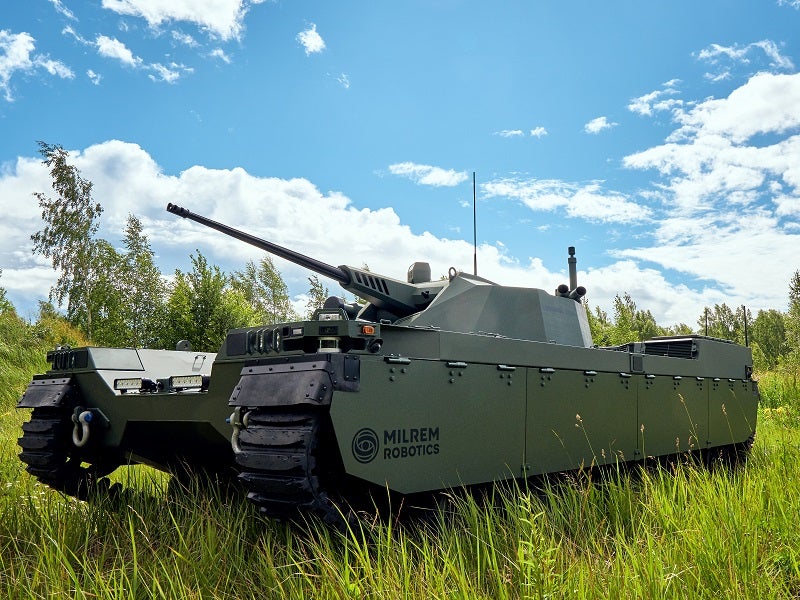Type-X Robotic Combat Vehicle (RCV) is a new unmanned tracked infantry fighting vehicle (IFV) intended to meet the multi-mission requirements of the armed forces worldwide.
Milrem Robotics, a robotic solutions provider based in Estonia, is developing the Type-X vehicle to reduce the number of soldiers on the battlefield. It is ideal for performing missions in dangerous situations, while keeping the required number of warfighters out of harm’s way.
The Type-X RCV with John Cockerill Defense’ Cockerill Protected Weapons Station Generation II (CPWS II) was showcased to select armed forces in June 2020.
Major components of the vehicle are being developed by the company’s Swedish and Estonian engineers.
The US Army is planning to procure the Type-X combat vehicles for its mechanised infantry units.
The unmanned IFV is expected to replace conventional fighting vehicles. It can be equipped with a cannon, an anti-aircraft system, a radar, and or a mortar.
In June 2021, the Type-X RCV was exhibited during the Military Robotics and Autonomous Systems (RAS) USA Conference 2021. It was designed to meet the requirements of the US Army’s RCV-M programme.
Design and features of Type-X RCV
The modern Type-X RCV will be based on a fully modular design approach and open architecture, which can be adoptable for multiple roles through the integration of upgraded sensors and other components.
The vehicle has an overall length of 0.6m, breadth of 0.3m, and height of 0.22m. The curb weight of the vehicle is 12,000kg, while its payload carrying capacity is 4,100kg. The unmanned IFV will be capable of carrying a variety of payloads based on the same interface to meet multiple mission requirements. It has the ability to operate in fully autonomous mode in the absence of a crew.
Weighing approximately 12t, the vehicle will support rapid deployment in the combat zones. It will supplement the main battle tanks and mechanised units in the battlefield, while reducing the reaction time.
The unmanned IFV combines augmented artificial intelligence (AI) with a remote system operator. The RCV’s lightweight design will allow for airdropping by either parachute or under-sling transport by a heavy lift helicopter.
The RCV has smaller volume and low heat signature compared to conventional IFVs. It can carry mesh-enabled communication modules to relay wireless communications.
Equipped with rubber tracks and hybrid propulsion, the vehicle will greatly reduce maintenance costs. The vehicle can be converted into autonomous or remotely controlled platform using Milrem Robotics’ Intelligent Functions Kit (IFK).
Type-X RCV armament
Type-X RCV can be armed with a multi-role Cockerill Protected Weapons Station Generation II (CPWS II). The CPWS II is a low profile, lightweight remotely operated weapon system integrating a configurable hatch opening. The turret will allow the crew to adjust the position of the hatch in three modes to match the mission needs.
The weapon system can be fitted with a range of 25mm and 30mm medium calibre guns such as Northrop Grumman Innovation Systems M242 25mm X 137mm Bushmaster cannon, the 230LF 30mm X 113mm cannon, or the Nexter 25mm M811.
The system is also compatible with anti-tank missiles such as Alcotan, MMP, Javelin or SPIKE to offer a maximum level of protection.
The turret offers a 360° panoramic sight and is equipped with CCD, thermal and fused imaging cameras to provide remote observation.
The weapon station with a hatch opening will allow a rapid reloading of the unmanned vehicle from the outside.
The Type-X vehicle proposed for the US army’s RCV-M requirement can be fitted with a 50mm cannon and a drone tethered to the vehicle’s system for situational awareness around the battlefield.
Control station
Type-X RCV’s control station will enable the vehicle to move autonomously in high-risk areas using global positioning system-based (GPS) position control and waypoint navigation.
The information captured by on-board sensors is evaluated by the operator at the control station in real time.
Features currently under development for the Type-X Combat vehicle are follow-me, teleoperation, and swarming.
Type-X RCV propulsion
The Type-X combat vehicle will be powered by a diesel-electric propulsion system, integrating a JP8 diesel engine and fully charged batteries.
The rubber tracks will offer enhanced mobility and smoother performance on difficult terrain conditions. It will offer a range of approximately 600km.




